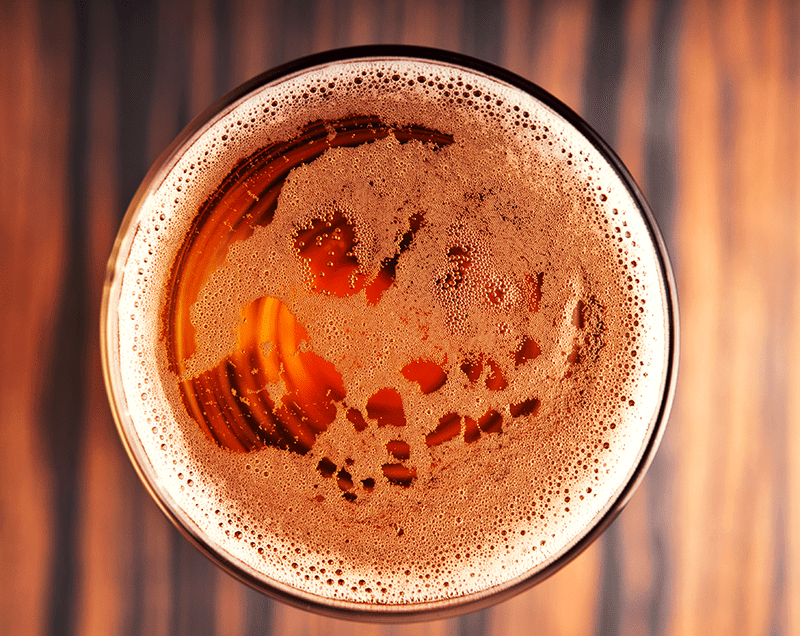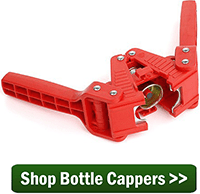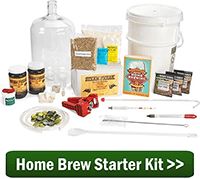 I brewed a batch of beer as directed. It has set for 4 weeks bottled in a room of 60 to 65 degrees. When opened it had almost no carbonation.
I brewed a batch of beer as directed. It has set for 4 weeks bottled in a room of 60 to 65 degrees. When opened it had almost no carbonation.
Name: Don C.
State: Mo.
—–
Hi Don,
Sorry your beer is still flat. Let’s see if we can figure out why it won’t carbonate.
Beer carbonates when beer yeast consumes sugar and excretes CO2, and the CO2 has no where to go but into solution because the beer bottle or keg has been sealed. Let me share some theories with you about what’s going on and some possible fixes for your flat beer.
The problem you’re describing is probably caused by one of the following:
- Not enough time/ the room’s not warm enough – I understand you’ve waited four weeks already, but if you did everything correctly, chances are very good that with more time and the beer bottles located in a slightly warmer room, your beer will carbonate. Some beer yeasts work more slowly than others, and high gravity beers generally take longer to carbonate. I know it’s tough with all that beer sitting there, but patience may be the answer to fixing you flat beer.
- Not enough priming sugar – If you brewed the beer as instructed, this probably isn’t the case. However, did the priming sugar get well-mixed into the beer? I usually pour the sugar/water solution into the bottling bucket first, then siphon the beer into it. This usually mixes things up pretty well. I also recommend checking out this calculator, which shows the correct amount of priming sugar to use based on temperature, desired carbonation level (vols CO2), and type of sugar.
- Non-fermentable or slowly fermenting priming sugar – If for some reason you used a non-fermentable sugar to prime your bottles, such as lactose sugar, it’s probably not going to give you any carbonation. Similarly, if you used a complex sugar to prime, it may just take longer for the yeast to ferment those complicated sugar molecules. Corn sugar, cane sugar, and dried malt extract work best for priming.
- Bad seal on the bottles
 – It’s possible that there isn’t a good seal on your beer bottles, allowing CO2 to escape. The result is a flat beer or a beer that won’t carbonate completely. This could be the case if you’re using a twist-off instead of pop-off style beer bottles. You could also just be getting a bad seal when you cap.
– It’s possible that there isn’t a good seal on your beer bottles, allowing CO2 to escape. The result is a flat beer or a beer that won’t carbonate completely. This could be the case if you’re using a twist-off instead of pop-off style beer bottles. You could also just be getting a bad seal when you cap.
- Yeast killed off – If there was sanitizer left in your bottles or bottling bucket, there’s a small chance that yeast got killed and whatever yeast that’s left is having a tough time carbonating your beer. If you use a “no-rinse” sanitizer on your bottling bucket and bottles, make sure the sanitizer dries completely before use. I usually rinse after sanitizing, even when using a no-rinse sanitizer.
How to fix a flat beer that won’t carbonate
So, what can be done to fix a flat beer? Here are a few possible ways to carbonate your beer, with the easiest and most likely solutions listed first:
- Hurry up and wait…then wait some more – The first thing I would do is move the bottles to a room that’s a little warmer, consistently around 70°-75°F degrees, to try to “wake up” the yeast into carbonating your beer. 99% of the time, this will fix your problem. If it doesn’t fix the problem after 8 weeks or so, you’ll need to take more drastic action. Keep in mind that higher gravity beers may just take longer to carbonate than others.
- Add more sugar – If you’ve already waited for eight or more weeks and know that you didn’t add enough priming sugar, you could open up each bottle and add a pinch more. It’s important to be very careful with this — if you add too much sugar, you could get some bottle bombs. It is possible to create so much carbonation pressure in the bottle that the glass will fail. Move the bottles somewhere safe where they won’t hurt anyone and won’t make too much of a mess if they explode.

- Keg it – In theory, you could open up all the beer bottles and pour them into a keg, then prime or force carbonate with CO2. Then again, if you have a keg, you probably wouldn’t be bottling, would you?
- Add more beer yeast – I’ve heard of homebrewers adding a few grains of dry yeast to each bottle of flat beer to help it to carbonate, but this sounds like a recipe for a bottle bomb, so I wouldn’t recommend it.
Again, if you did everything right, the best thing to do is just wait it out. I’m as guilty as anyone of opening up a homebrew before it’s ready, but in homebrewing, as in life, patience is a virtue. Give your flat beer some more time, and see if that doesn’t get it to carbonate.
Thanks again for your question and good luck,
David Ackley
—–
David Ackley is a beer writer, brewer, and self-described “craft beer crusader.” He holds a General Certificate in Brewing from the Institute of Brewing and Distilling.

I think I may have killed off my yeast during bottling. It’s was my first time using a “no rinse” sanitizer and I noticed that I had left a few drops in each bottle before I bottled. I was just notified that wasn’t a good idea. I see now that my beer is flat after 2 weeks conditioning in temps ranging from 72-75 (f) degrees. Is there any way I can save my brew?! (PS, I live in Florida and my beers FG was at 8%)
Alex, I wouldn’t do anything just yet. Take a couple of bottles and put them in a consistently warm place for another week. Like a top shelf of a kitchen cabinet, someplace like that. Sometimes it just needs more time and a little more warmth. If you see any improvements, forget about the other bottles for a month or two and they should eventually be fine. If you do not see any improvement, there is no easy way to redo the batch. You can try adding a grain of dried yeast to each bottle, but this is not very sanitary and inconsistent.
Could you please give me some hints on how to clean my empty beer bottles?
Brett, cleaning beer bottles can be as simple as using dish soap to remove any debris or particles in the bottle. I would recommend using a bottle brush so that you can scrub down into the bottle. When you are ready to use them again you will also need to sanitize them just before use. We offer several choices for cleaning and sanitizing your bottles. Below you will find the link to our bottle cleaning supplies as well as an article on cleaning wine bottles which is not much different than cleaning beer bottles.
Cleaning And Sanitizing Beer Bottles
http://www.eckraus.com/home-brew-cleaning-sanitizing
http://www.eckraus.com/blog/sanitizing-cleaning-wine-bottles
I know this is old, but if you have a dishwasher with a sanitizing cycle, you can put your bottles in the diswasher inverted on the sanitizing cycle, then leave the dishwasher closed until just before bottling. Its worked for my friend and I, and the bottles are usually perfectly dry by the end of the drying cycle. You also don’t have to worry about sanitizer affecting the yeasts metabolism of the priming sugar.
I would like to comment on the flat beer. Every thing that I heard is good! I have had this happen and just when I was ready to poor it down the drain, It finished carbonating . But one thing that I learned the hard way was the bottles. Do not use twist top bottles. I thought I hit the jack pot when my neighbor gave me 10 cases of empty bud light bottles. Then made 3 batched of beer to find that only 1 out of 3 sealed enough to carbonate. Good LUCK!
Adding a few grains of dry yeast to each bottle will not create bottle bombs! Too much sugar creates bottle bombs, not too much yeast!
Yes, though pending if all the sugars prior had fermented out. Its best to check sugar levels before attempting to add yeast. Though, adding carb drops will help as these are measured out. 2 per 740ml plastic bottles. Atleast this way you are not guessing and have a fighting chance to carbonate the beer.
So… this will be obvious after you read this, but I’m new to making beer and I’m afraid I missed messed up on two things. 1) I had an emergency and got pulled away from the bottling process right after I mixed in the sugar and didn’t get it into the bottles (2 cases) until the next morning, about 12 hrs. later. And 2) after I got it into the bottles, I put the them directly into the fridge to carbonate. One week later I re-read the instructions and saw that that the bottles were supposed to carbonate at around 70 degrees or so. Obviously I missed that. That was a week ago. I just pulled them out of the fridge now and set them in a dark room with the thermostat set at 72. I have have my fingers crossed that they’ll still carbonate. Anything I should do right away, or just wait to see what happens in a few weeks?
Stu, at this point would just wait and see. If it does not carbonate, please take a look at the article posted below on tips to help.
My beer Will Not Carbonate
https://blog.eckraus.com/my-beer-is-flat-wont-carbonate
We brewed ten gallons of a dark Scottish red.
I put both carboys in the house and they started working immediately.
Unfortunately, I may have had the carboys too full because the yeast pushed foam out thru the airlocks.
This crusted over the airlocks and the CO2 could not escape.
I had to remove and clean the airlocks five times before the yeast quit working.
The beer came out very dark and tasty, but is extremely flat.
We kegged the beer and I have been force carbonating it almost daily, for weeks, all to no avail.
The beer has a great flavor, but is so flat that it is not good to drink.
I have researched repairs, but only find info on force carbonation (which I am already doing).
I was wondering if we could return the beer to the carboys and add yeast again.
But, if all the sugars are gone, this really wouldn’t help.
So…do we just have ten gallons of undrinkable beer or is there anything that we can do?
Bluto, first let us start by saying that you did not lose all of the yeast because the fermentation overflowed. You may have lost some of the yeast if you allowed the beer to settle out too long. It could be your process when force carbonating that is causing the problem. Try using our method of using 35jpounds of pressure for 3.5 days while the beer is cooling down to 35 degrees. Hopefully this will solve the problem. For more information, please see the article posted below.
Kegging Beer
https://blog.eckraus.com/how-to-fill-a-keg-with-homebrew
Thank you for you response.
I will up my CO2 pressure to about 35 psi and try that.
Have tried the increased psi forced carbonation for weeks, to no avail.
Nothing seems to help.
Again, the beer tastes really good, but is sooo flat that it is undrinkable.
Sadly, I think I may have to dump it and brew a new batch.
Thank you for your responses and trying to help.
I’m experiencing a similar problem, went off script on a nut brown and added a gallon of honey. re-pitched in the same carboy 2 weeks later because our gravity was so high. we bottled with priming sugar by the book but they never carbonated. tastes like a mead but flat. I’m going to move them in to a warmer room to see if it makes any changes.
So my beer comes off with a big fat creamy head but… after just a few minutes the head dies down to nothing leaving no lacing and zero additional bubbles rising to the surface. I am using a whole barley recipe and no rinse sanitizer. Any ideas?
Sean, i would recommend taken a look at the article posted below that discusses this very topic.
Increasing Beer Head Retention And Body
https://eckraus.com/wine-homebrew-blog/increasing-beer-head-retention-and-body/
I put the cases of beer on a heat pad to 75 degrees for 3 weeks and the beer now has a nice carbonation. It was just not warm enough for the yeast to work.. many thanks Don